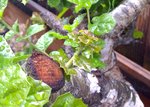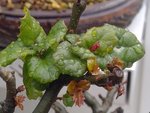BrianBay9
Masterpiece
I've seen an interesting dichotomy in the new growth coming out of my newly collected Q. agrifolia. Some have red buds and new growth, while the typical case is green buds and new growth. All the growth eventually turns green but some trees start out red.



In researching this it seems that in parts of its range, coast live oak hybridizes with California black oak (Q. kelloggii), and in many cases these hybrids have leaf shape like Q agrifolia, but red buds and new growth like Q kelloggii. Not that important, perhaps, but an interesting fact. Oaks (at least California oaks) apparently hybridize all over the place.



In researching this it seems that in parts of its range, coast live oak hybridizes with California black oak (Q. kelloggii), and in many cases these hybrids have leaf shape like Q agrifolia, but red buds and new growth like Q kelloggii. Not that important, perhaps, but an interesting fact. Oaks (at least California oaks) apparently hybridize all over the place.

